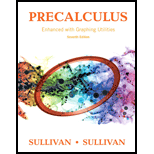
Concept explainers
To find: Instantaneous Velocity of a Ball In physics it is shown that the height of a ball thrown straight up with an initial velocity of from ground level is,
where is the elapsed time that the ball is in the air.
a. When does the ball strike the ground? That is, how long is the ball in the air?
To find: Instantaneous Velocity of a Ball In physics it is shown that the height of a ball thrown straight up with an initial velocity of from ground level is,
where is the elapsed time that the ball is in the air.
b. What is the average velocity of the ball from ?
To find: Instantaneous Velocity of a Ball In physics it is shown that the height of a ball thrown straight up with an initial velocity of from ground level is,
where is the elapsed time that the ball is in the air.
c. What is the instantaneous velocity of the ball at time ?
To find: Instantaneous Velocity of a Ball In physics it is shown that the height of a ball thrown straight up with an initial velocity of from ground level is,
where is the elapsed time that the ball is in the air.
d. What is the instantaneous velocity of the ball at ?
To find: Instantaneous Velocity of a Ball In physics it is shown that the height of a ball thrown straight up with an initial velocity of from ground level is,
where is the elapsed time that the ball is in the air.
e. When is the instantaneous velocity of the ball equal to zero?
To find: Instantaneous Velocity of a Ball In physics it is shown that the height of a ball thrown straight up with an initial velocity of from ground level is,
where is the elapsed time that the ball is in the air.
f. How high is the ball when its instantaneous velocity equals zero?
To find: Instantaneous Velocity of a Ball In physics it is shown that the height of a ball thrown straight up with an initial velocity of from ground level is,
where is the elapsed time that the ball is in the air.
g. What is the instantaneous velocity of the ball when it strikes the ground?
Want to see the full answer?
Check out a sample textbook solution
Chapter 14 Solutions
Precalculus Enhanced with Graphing Utilities (7th Edition)
Additional Math Textbook Solutions
University Calculus: Early Transcendentals (4th Edition)
College Algebra (7th Edition)
Introductory Statistics
Algebra and Trigonometry (6th Edition)
Thinking Mathematically (6th Edition)
A First Course in Probability (10th Edition)
- Use a graphing utility to find the point of intersection, if any, of the graphs of the functions. Round your result to three decimal places. (Enter NONE in any unused answer blanks.) y = 100e0.01x (x, y) = y = 11,250 ×arrow_forward5. For the function y-x³-3x²-1, use derivatives to: (a) determine the intervals of increase and decrease. (b) determine the local (relative) maxima and minima. (e) determine the intervals of concavity. (d) determine the points of inflection. (e) sketch the graph with the above information indicated on the graph.arrow_forwardCan you solve this 2 question numerical methodarrow_forward
- 1. Estimate the area under the graph of f(x)-25-x from x=0 to x=5 using 5 approximating rectangles Using: (A) right endpoints. (B) left endpoints.arrow_forward9. Use fundamental theorem of calculus to find the derivative d a) *dt sin(x) b)(x)√1-2 dtarrow_forward3. Evaluate the definite integral: a) √66x²+8dx b) x dx c) f*(2e* - 2)dx d) √√9-x² e) (2-5x)dx f) cos(x)dx 8)²₁₂√4-x2 h) f7dx i) f² 6xdx j) ²₂(4x+3)dxarrow_forward
- 2. Consider the integral √(2x+1)dx (a) Find the Riemann sum for this integral using right endpoints and n-4. (b) Find the Riemann sum for this same integral, using left endpoints and n=4arrow_forwardProblem 11 (a) A tank is discharging water through an orifice at a depth of T meter below the surface of the water whose area is A m². The following are the values of a for the corresponding values of A: A 1.257 1.390 x 1.50 1.65 1.520 1.650 1.809 1.962 2.123 2.295 2.462|2.650 1.80 1.95 2.10 2.25 2.40 2.55 2.70 2.85 Using the formula -3.0 (0.018)T = dx. calculate T, the time in seconds for the level of the water to drop from 3.0 m to 1.5 m above the orifice. (b) The velocity of a train which starts from rest is given by the fol- lowing table, the time being reckoned in minutes from the start and the speed in km/hour: | † (minutes) |2|4 6 8 10 12 14 16 18 20 v (km/hr) 16 28.8 40 46.4 51.2 32.0 17.6 8 3.2 0 Estimate approximately the total distance ran in 20 minutes.arrow_forwardX Solve numerically: = 0,95 In xarrow_forward

 Functions and Change: A Modeling Approach to Coll...AlgebraISBN:9781337111348Author:Bruce Crauder, Benny Evans, Alan NoellPublisher:Cengage LearningAlgebra & Trigonometry with Analytic GeometryAlgebraISBN:9781133382119Author:SwokowskiPublisher:Cengage
Functions and Change: A Modeling Approach to Coll...AlgebraISBN:9781337111348Author:Bruce Crauder, Benny Evans, Alan NoellPublisher:Cengage LearningAlgebra & Trigonometry with Analytic GeometryAlgebraISBN:9781133382119Author:SwokowskiPublisher:Cengage
 Big Ideas Math A Bridge To Success Algebra 1: Stu...AlgebraISBN:9781680331141Author:HOUGHTON MIFFLIN HARCOURTPublisher:Houghton Mifflin Harcourt
Big Ideas Math A Bridge To Success Algebra 1: Stu...AlgebraISBN:9781680331141Author:HOUGHTON MIFFLIN HARCOURTPublisher:Houghton Mifflin Harcourt Algebra and Trigonometry (MindTap Course List)AlgebraISBN:9781305071742Author:James Stewart, Lothar Redlin, Saleem WatsonPublisher:Cengage Learning
Algebra and Trigonometry (MindTap Course List)AlgebraISBN:9781305071742Author:James Stewart, Lothar Redlin, Saleem WatsonPublisher:Cengage Learning





